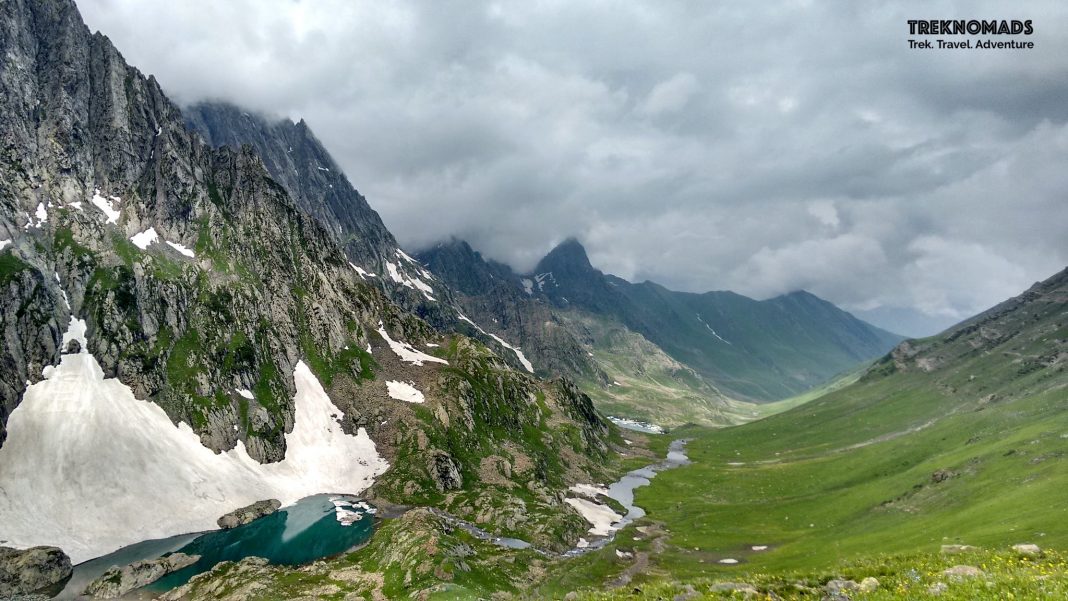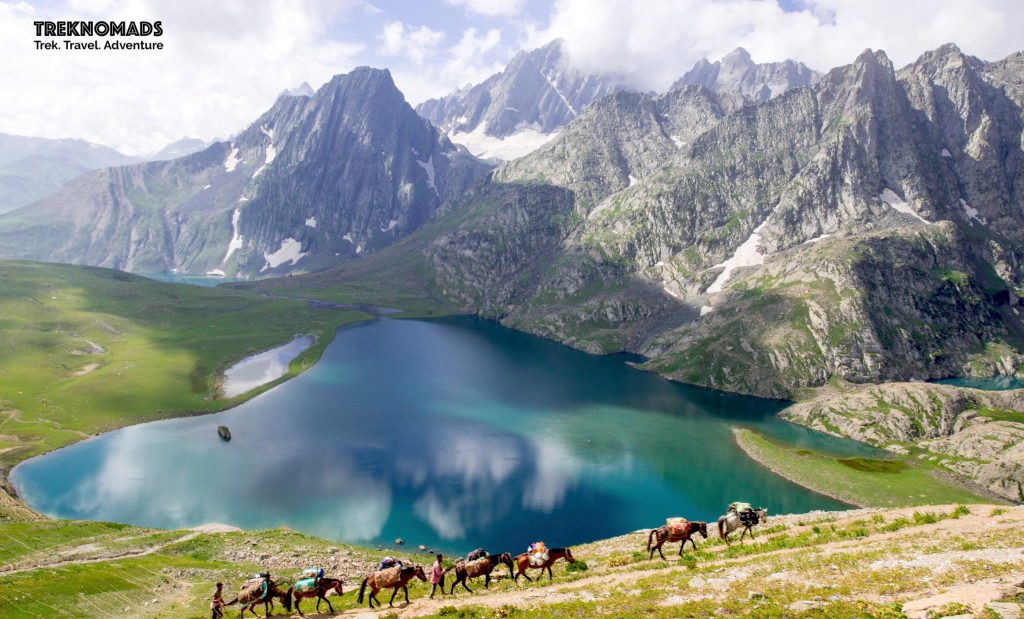Kashmir is undoubtedly one of the most heavenly places on Earth. With pristine high altitude lakes such as – Gadasar, Satsar, Nundkol, Gangbal, Vishansar, and Krishnasar, the Kashmir Great Lakes Trek (commonly called KGL) explores these lakes and is one of the most sought after treks in the region. So, if you wish to do the trek, you have may have a few queries, this blog on the Kashmir Great Lakes trek faqs will help answer your queries and get you ready for the trek!
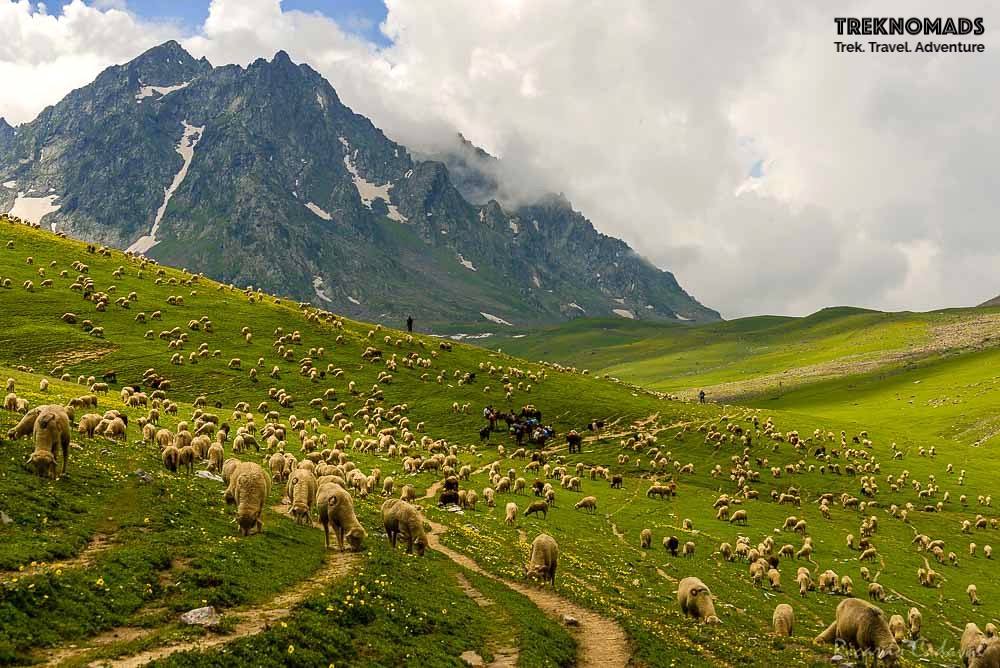
Kashmir Great Lakes trek FAQs – Answered
1. What is the best time to do the KGL Trek?
The Kashmir Great Lakes trek opens up for trekkers between the months of July to September. The reason being all the other months, you will find Kashmir engulfed in snow due to extreme weather conditions which makes it difficult to trek in the snow.
While the rest of the country experiences the monsoon season during this time, including most trails in Uttarakhand like Valley of Flowers. However, Kashmir is an exception. This is primarily because, the Pir Panjal range that separates Kashmir from the rest of the Indian subcontinent, blocks the monsoons.
In fact, July to September is considered to be peak summers transitioning to Autumn. This is also one of the reasons why Kashmir is just breathtaking during these months. The colors you get to see and the landscape keeps changing over a period of three months and Kashmir gets ready to welcome Autumn.
What to expect between July – September:
- Early July – Patches of snow at higher altitudes (Nichnai and Gadsar Pass), fresh green colors, flowers beginning to bloom.
- Mid-July – Mid-August – Most of the snow would have melted. This is also the warmest period in Kashmir. You will find dramatic landscapes with breathtaking colors. There will be mild showers here and there but nothing to be concerned about. (You might experience evening showers on certain days during this time of the year. This is why it is a good practice to cross the pass early in the day and reach the next campsite by or before 4 PM.)
- Mid-August to September – You will see a considerable drop in the temperature. Also due to which flowers start to wither away, skies are mostly clear and blue with intermittent showers. You will notice snowfall post-mid-September.
Kashmir does not have Monsoon spills so the KGL trek is probably one of the best Himalayan Monsoon trek in India.
2. What is the difficulty level of the Kashmir Great Lakes trek?
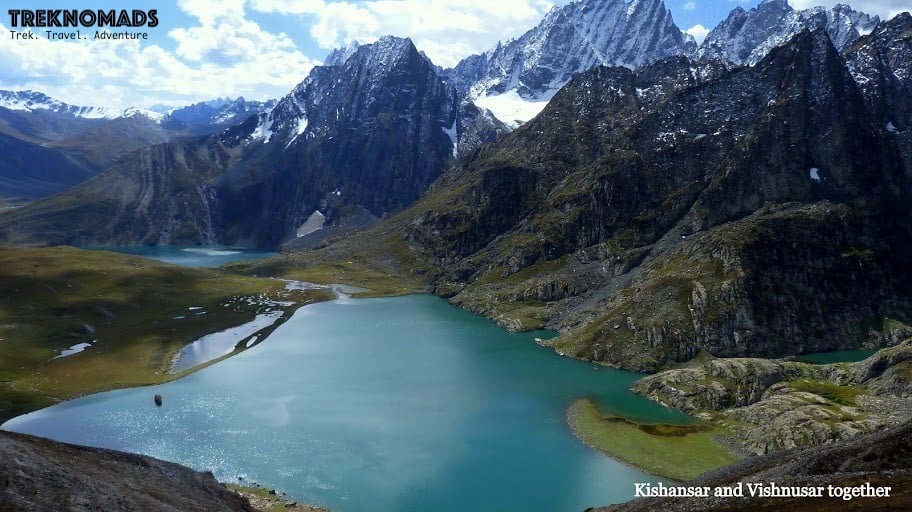
One of the most common questions we wish to address with this Kashmir Great Lakes trek faqs blog is the difficulty level of the trek. The KGL trek starts from Sonamarg which lies at an altitude of 9,186 ft (2,800 m) and gradually takes you to the highest altitude of 13,800 ft (4,200 m). As per our experience and given the terrain of this trek, we rate it as a moderate trek.
You will be trekking for 7 days with one day as buffer/rest. The average distance covered will be between 12 Km every day. This also means that you will spend anywhere between 5 to 8 hours climbing during the day. This can change based on your fitness level and the pace of the group. The climbs are steep and hence require a good amount of physical fitness from Nomads who wish to take on this trek. There is a combination of ascending 1500 ft and descending 1500 ft every day during the trek.
While the photos of KGL may show you vast meadows and mostly flat surfaces, this trek can get challenging.
We have observed three different challenging – difficult sections that you will come across on this trek:
1. The climb to Nichnai Pass
2. The climb to Gadsar
3. Tricky, boulder section after Satsar
1. The climb to Nichnai on the first day of trek:
This is the only trek with such a challenging first day. You gain more than 3,000 ft in a span of 6-7 hours. It is safe to say that this climb will definitely test your endurance.
Also, since you gain such an altitude rapidly, you may also show signs of Altitude Mountain Sickness (AMS). If you notice yourself having any of the AMS symptoms, please inform your trek lead/captain immediately.
2. The Climb to Gadsar Pass:
This is a steep one and can leave you tired if you have not prepared well for the trek. The climb is steeper, arduous, on the stark landscape of the Kashmir Valley. Although you climb in a series of switchbacks, to keep going requires physical as well as mental toughness.
3. Boulder section between Satsar to Gangbal:
On this day, you will come across a 40-minute long section filled with big boulders. There is no trail here. You will need to hop skip and jump on this section to cross it. It could get difficult if you are not nimble on your feet or are not mentally prepared for this.
3. What is the temperature like?
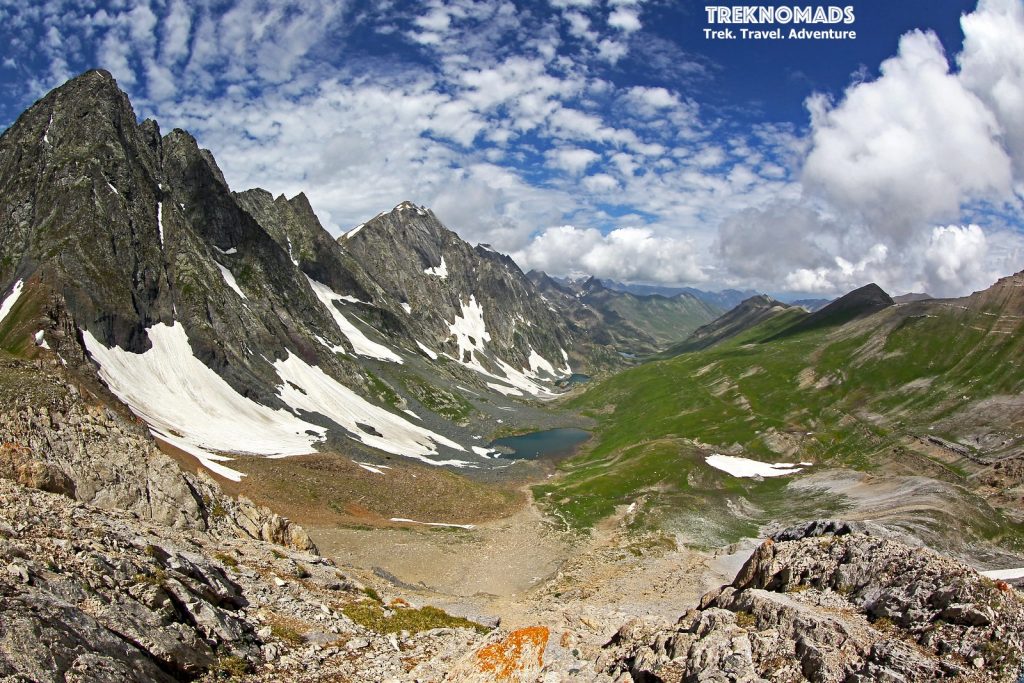
Weather and temperature are some of the most important aspects one should know before heading out on a trek. This Kashmir Great Lakes trek faqs blog helps cover all aspects of weather and temperature that can you help prep right for the trek.
As mentioned above, due to the Pir Panjal mountain range, Kashmir lies in the rain shadow region. This is the reason why Kashmir receives mild rainfall during this period (July to August).
July, when we start the Kashmir Great Lakes trek is peak summer. While the days at the plains of Srinagar can be warm between 25 to 30° C, the mountains are pleasant. The sun can be harsh during the day when overhead. Evenings and nights are balmy hovering around 5 to 8° C at the high camps.
Temperature and weather in July to mid-August:
These are easily the warmest months in the Kashmir Valley. The temperatures during the day can easily go up to 20° C and nights are cool and calm with standard temperatures around 5° C. This same temperature can be noticed in the higher camps as well.
#TrekNomadsRecommends: Wearing a sun cap can be a lifesaver as it saves your head from the harsh sun.
As mentioned earlier, there will be mild rain on the trail, however, nothing can stop you from trekking. There may be rain in the late afternoon and evenings. But don’t be surprised if you see rains throughout the day sometimes.
#TrekNomadsRecommends: Good rain gear like a rain poncho or a raincoat with a good pair of waterproof boots should help you trek with ease.
Temperature and weather in the end of August to September:
As you proceed towards the end of August, you will notice a dip in the temperatures in the Kashmir Valley. September sees a drastic dip of at least 3-4° C week on week. Night temperatures can go beyond -3° C and sometimes up until -5° C, as you increase your altitude.
#TrekNomadsRecommends: If you’re trekking in the last week of August or in September, make sure you are well-prepped with winter gear to save yourself from the cold.
It is also noticed that the Satsar campsites experience windchill with strong cold winds during the evenings decreasing the temperatures even further down. This is primarily due to its positioning as a plateau.
4. What to pack for the Kashmir Great Lakes trek?
Packing right for your trek is as important as physical training that helps you prep for the trek. This will not only ensure you have all that you need during the trek, it will also ensure that you have a great trek experience which can otherwise be ruined when you find out you’ve either carried too much or too little.
As a part of this Kashmir Great Lakes trek faqs, we have created a detailed guide on what you need to pack for the trek,you can download the checklist of things to carry here.
5. What are the COVID protocols to be followed while traveling to Kashmir?
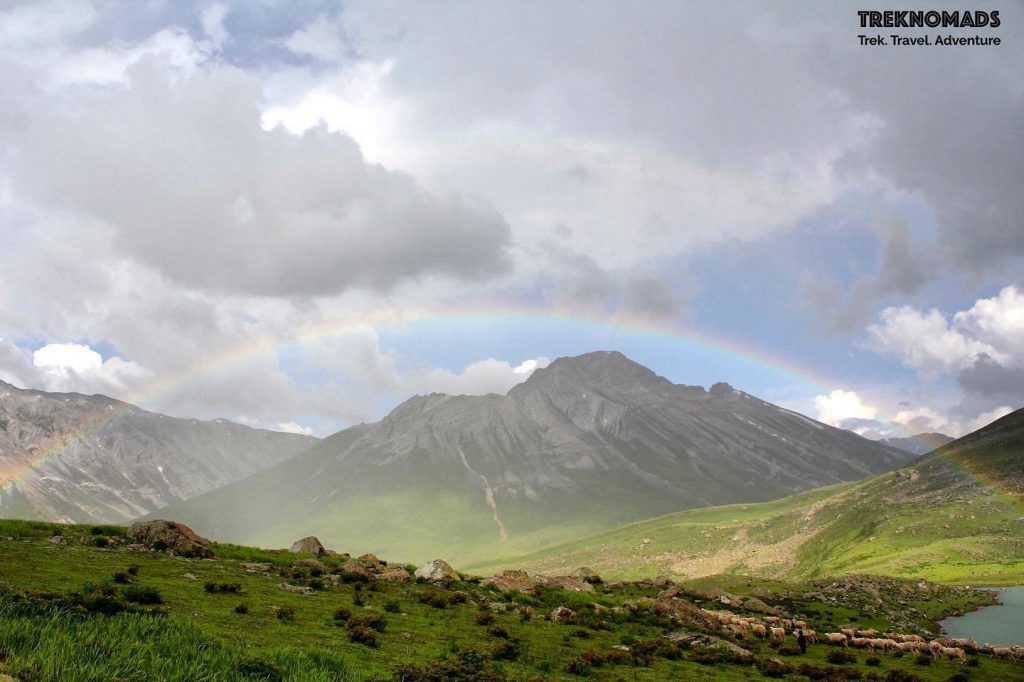
With the current ongoing pandemic and changing protocols, you may be wondering what the current set of COVID protocols are. Don’t worry, this Kashmir Great Lakes faqs guide covers that too: *(last updated on 19 July 2021)*
- Jammu & Kashmir requires all travelers to carry a negative RT-PCR report not earlier than 72 hours from an ICMR approved laboratory.
- If you do not have a COVID negative report at the time of travel, you will be required to get a rapid antigen test at the airport. This test is free of cost. Once you do the test, you can leave the airport and proceed to your hotel/stay, however, you will need to be quarantined until you get the test results. If you end up testing positive, you will be expected to quarantine at your respective hotel/resort or at a designated quarantine facility. (**TrekNomads will not be responsible for arranging your quarantine stay at Srinagar in the case that you test positive.)
- Adding to the above, during departure to your destination, you will be expected to follow the rules of the arrival of your particular state. (**TrekNomads is not responsible for arranging or booking your COVID swab collection or test report before you travel back to your hometown.)
6. Where is the assembly point of this trek and how to get there?
The trek starts from Srinagar in Kashmir. While this is not the base camp of this trek, this is where we all assemble, meet, and greet fellow trekkers, and prep for the trek.
By Air: The easiest way to reach Srinagar is via Air. There are also flights from Jammu, Delhi, Mumbai, Ahmedabad, Chandigarh, Amritsar, Kolkata, Bangalore, and Lucknow.
By Bus: The Jammu and Kashmir State Road Transport Corporation operates an inexpensive bus service from the airport to the Tourist Reception Center in Srinagar. Otherwise, expect to pay about 1,000 rupees for a prepaid taxi (2018 prices). App-based taxi services such as Uber and Ola don’t operate in Kashmir.
By Train: If you’re traveling on a budget and are feeling adventurous, you may try taking an Indian Railways train to Jammu (these trains start from Delhi or pass through Delhi from other cities in India), and then go by shared jeep/taxi to Srinagar (traveling time around eight hours). Buses also run but they are much slower, taking around 11-12 hours for the journey.
7. What Documents to carry for the Kashmir Great Lakes trek?
When it comes to Kashmir Great Lakes faqs, we want you to be completely prepped and that includes what documents you need to carry for the trek as well.
- Original and 3 Photocopies of your Government ID proof anything such as Aadhaar/Passport/Driver’s License will do. This will need to be submitted to the Forest department for your trekking permit
- Passport Size photos – 3 to 4 copies
- Medical Certificate (will be shared with you post-registration)
- Indemnity bond (will be shared with you post-registration)
Please carry these documents in a plastic cover and place them securely inside your backpack so that they do not get wet.
8. What about accommodation on the trek?
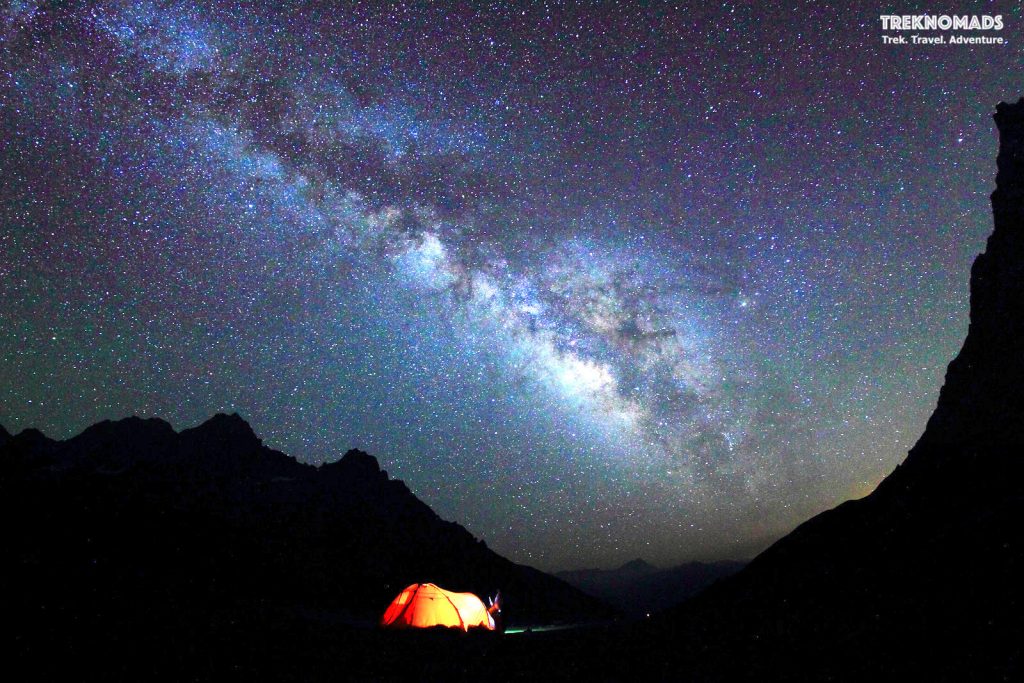
Accommodation during the trek will be as follows:
- At Srinagar on arrival – 1 Night stay on a deluxe house-boat at Dal Lake (Sharing basis)
- During the trek – 7 Night Camp stay along the trail during the trek (Sharing basis)
- Post trek stay – 1 Night stay at a three/four-star hotel in Srinagar (Sharing basis)
How are we maintaining safety and hygiene during the trek?
We are following strict COVID safety protocols on all our treks, this includes treks with camping accommodation as well. As per travel regulations, trekkers will need to be COVID -ve to take part in the trek, our guides and trek lead in Srinagar will also be tested 72 hours before meeting the teams.
As a part of our extensive COVID safety protocols, our on-ground teams will be sanitizing your tents and your sleeping bags every day before and after usage (for all 7 camping days). We recommend that you carry a sleeping bag liner for your safety and hygiene purposes.
9. Is food included in the trek?
During your trek, we ensure that you do not have to worry about which includes making sure you eat healthy, nutritious, and delicious food during the entire duration.
- Breakfast, lunch, dinner, evening snacks during the trekking days
- Breakfast and dinner during your stay in Srinagar
10. What type of food can be expected on the trail?
We serve standard vegetarian food on the trail, we also make sure we keep in mind any kind of food allergies that you may have. We believe in hearty meals and that is what we aim to provide on our treks so that you and your tummy are happy and healthy. There will be a cook and a kitchen assistant who will trek with us to ensure they cook scrumptious meals for you every day.
11. Will I have to carry my own rucksack or can I hire a porter?
You can either choose to carry your backpack or you can hire a porter for an extra cost. The same can be conveyed during the time of booking.
12. What about electricity on the trek?
Unfortunately, there is no electricity on the trail. It is only available till Srinagar. The trekkers camp on the second day during which electricity is not available. It is recommended that on your day of arrival and during your stay at the boathouse, you charge all your camera batteries and your power banks.
13. How to charge mobile phones/cameras?
You can carry two fully charged 20000mah power banks and make sure you keep your phone on flight mode to save battery.
14. How is the connectivity in Srinagar?
If you have a cell phone with a prepaid connection, your SIM card will not work as roaming has been blocked in Kashmir due to security reasons (postpaid connections are fine). Only a postpaid connection works in Srinagar. During the trek, you may find intermittent networks here and there for calling only for BSNL, Vodafone, and Airtel. Internet may or may not be there.
15. Which is the nearest hospital on the trek?
In case of a medical emergency, the closest hospital will be found around Sonamarg, at Baltal or Kangan. If you need serious medical attention, head to Srinagar for better facilities.
- Khyber Hospital, Srinagar – Ph: (0194) 2455130, (0194) 2455119
- Florence Hospital, Srinagar – Ph: (0194) 2440860, (0194) 2440760
16. Why is there a buffer day on Day 7?
This is a backup plan to accommodate unforeseen circumstances such as bad weather on the trek or in the case of political instability where we can’t travel back to Srinagar immediately. This depends completely on the circumstances of the trek and the situation in Kashmir.
17. Can we get alcohol in Srinagar?
No, alcohol isn’t served in restaurants and most businesses shut for prayer at lunchtime on Friday in Srinagar. Bars can be found in select upmarket hotels though.
18.Is Kashmir safe for visitors and trekkers?
Yes, Kashmir and the Kashmir Great Lakes trek is safe. However, with this Kashmir Great Lakes trek faqs blog, we would like to keep you well-informed on this sensitive topic.
The trek trail is in a remote region of Kashmir away from the turmoil and unrest which also happens to be a touristy region. Further, there are about 3 army camps on the trek trail which ensures that the trail is safe.
Political unrest is something that may happen in Kashmir and if it does, we are prepped to ensure the safety of our trekkers without compromising on this aspect. We travel only during non-curfew hours and take all measures necessary to pick up and drop trekkers from and to the airport.
In the case the situation gets worse, we will take a call and call off the trek. This is a worst-case scenario that has not happened yet. But if it does, we will make sure you get accommodation in Srinagar or you can leave for your hometown.
We always keep our trekkers in mind while conducting treks, and so, you can be rest assured that trekking is safe.
